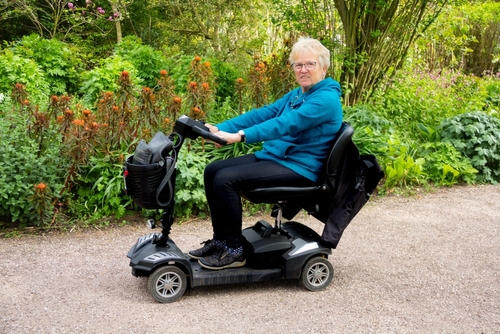If you struggle to get out and about because walking is difficult, this article has all you need to know about how to get a mobility scooter for free in UK, second hand mobility scooters and what to consider when buying this mobility aid.

Page contents
- What is a mobility scooter?
- Who can use mobility scooters?
- Do I need one?
- How much is a mobility scooter?
- Can I get a mobility scooter for free in UK?
- How do I qualify for a free scooter?
- Can I hire, borrow or get a second hand mobility scooter?
- How much is a mobility scooter on PIP?
- What charity gives free mobility scooters?
- How do I qualify for a free mobility scooter from the Mobility Trust?
- How can I apply for a free mobility scooter?
- How can I buy one in the UK?
- What to consider when buying a scooter
- Types of mobility scooters
- What class is your scooter?
- How can I tell what class my scooter is?
- Are mobility scooters allowed on the road?
- Do you need a driving licence for a mobility scooter?
- How fast can mobility scooters go?
- Mobility aids: Benefits of a mobility scooter
Page contents
- What is a mobility scooter?
- Who can use mobility scooters?
- Do I need one?
- How much is a mobility scooter?
- Can I get a mobility scooter for free in UK?
- How do I qualify for a free scooter?
- Can I hire, borrow or get a second hand mobility scooter?
- How much is a mobility scooter on PIP?
- What charity gives free mobility scooters?
- How do I qualify for a free mobility scooter from the Mobility Trust?
- How can I apply for a free mobility scooter?
- How can I buy one in the UK?
- What to consider when buying a scooter
- Types of mobility scooters
- What class is your scooter?
- How can I tell what class my scooter is?
- Are mobility scooters allowed on the road?
- Do you need a driving licence for a mobility scooter?
- How fast can mobility scooters go?
- Mobility aids: Benefits of a mobility scooter
What is a mobility scooter?
When it comes to mobility aids, a mobility scooter is a single-seat vehicle powered by a battery.
They can transport you indoors or outdoors if you have trouble walking.
It has handlebars or a tiller, which makes the vehicle look similar to a motorbike or bicycle.
Also described as disability scooters or disabled scooters, these vehicles are often powered by a battery, have a seat, a foot platform and storage space.
Key features include:
- Handlebars or Tiller: Steers and controls speed and direction.
- Rechargeable battery: Powers motor.
- Mile range: 10- 30 miles on a single charge.
- Wheels: 3 wheels suitable for pavements or 4 wheels which is more stable for roads, rough terrain, steep hills.
- Armrests can be detachable, fixed position or fold up/swing away.
- Backrest can be adjustable angle, folding or not folding.
- Structure can dismantle, fold or be rigid.
Who can use mobility scooters?
You can only use a mobility scooter if:
- You have trouble walking because of an injury, physical disability or medical condition.
- Or, you’re taking the vehicle to or from maintenance or repair.
- Or, you’re the manufacturer testing the vehicle.
- Or, you’re demonstrating the vehicle before it’s sold.
- Or, you’re training a disabled user.
Bear in mind, if the above does not apply to you and you have an accident, you will receive the same penalty as if you were driving a car, which means you may get a driving ban, get an unlimited fine or you can go to prison.
Do I need one?
If you struggle to walk, perhaps because of older age, injury, disability, or an illness, a mobility scooter can help get you where you want to go.
You may want to consider whether an adapted car, Wheelchair Accessible Vehicle (WAV) or powered wheelchair , is the right choice for you. One woman describes why she wants a mobility scooter:
‘I’d say that one of my worst symptoms with the MS is fatigue. I used to enjoy walking but find it very tiring.
“I’ve realised that it’s putting me off doing things that I like – art galleries and museums with my husband. We went to a museum last week and I could only manage the main museum hall then I was done for! We’re planning a trip to an art exhibition but I know that I’ll find it really tiring. So I’ve started thinking about a mobility scooter. “
MS Society UK’s forum
How much is a mobility scooter?
A new mobility scooter costs between £3,000-£15,000, according to the Mobility Trust. You may, however be able to buy one for as little as £500, particularly if you get a second hand mobility scooter (see further down).
Can I get a mobility scooter for free in UK?
It is uncommon to get a mobility scooter in the UK for free.
Mobility scooters are not generally available on the NHS.
However, you may be able to get funding for them from the Motability Scheme, your local council and charities.
A care needs assessment can help identify your care needs. This assessment can result in the local authority providing you with care and support you need, which may include mobility equipment. You can contact your local council and ask them to carry out a care needs assessment.
How do I qualify for a free scooter?
To qualify for a free mobility scooter in the UK, you must meet the eligibility criteria for specific benefits and grants.
- This includes the Enhanced Rate Mobility Component of Personal Independence Payment (PIP) -£77.05 a week.
- The Higher Rate Mobility Component of DLA (Disability Living Allowance) – £77.05 a week.
- Child Disability Payment – £77.05 a week.
- Adult Disability Payment – £77.05 a week.
- Armed Forces Independence Payment (AFIP) The higher rate mobility part – £77.05 a week.
- War Pensioners’ Mobility Supplement (WPMS) – £86.00 a week.
The Motability Scheme can help you lease a scooter, as long as you receive a qualifying mobility allowance with at least 12 months left.
You can also get maintenance, servicing, insurance and breakdown cover as part of the Motability scheme.
Can I hire, borrow or get a second hand mobility scooter?
You can borrow mobility equipment for short periods from ShopMobility centres.
- Some charities or local organisations have refurbished, second hand mobility scooters available at a cheaper cost. Here is a useful guide to buying a second hand mobility scooter. If you do decide to buy a second hand mobility scooter, you should check for common faulty issues. These include a battery that is performing badly, worn tyres, a faulty ignition switch, and problems with steering.
- Hiring a mobility scooter for limited use, such as a holiday, is another option. You could also try your local ShopMobility centre to check whether it hires mobility scooters.
Mobility scooters may be available to use for short periods from the NHS or the Red Cross.
How much is a mobility scooter on PIP?
If you’re awarded the higher rate mobility part of Personal Independent Payment (PIP), (£77.05 a week) and you have at least 12 months left, you’re eligible to apply for the Motability Scheme.
You can exchange all or part of this PIP mobility allowance to lease a scooter through this scheme.
How much you pay towards a scooter, depends on the mobility allowance you receive from the UK government and the type of scooter you choose. You can check if you are eligible for the Motability scheme here.
You may qualify for a grant from a charity, or a loan from your local council’s mobility service if you are unable to walk and require support with daily activities.
What charity gives free mobility scooters?
To get a mobility scooter for free in the UK, you can apply for a grant from charities like The Mobility Trust, if you meet their criteria.
Mobility Trust is a charity providing free mobility scooters to people who need it but cannot afford it or get it from statutory means.
It does not give grants to individuals to fund the purchase of mobility scooters.
The Mobility Trust funds your first three years of the vehicle’s insurance free. It also gives two years of free servicing and maintenance. The Trust does not provide folding/ portable scooters.
How do I qualify for a free mobility scooter from the Mobility Trust?
The Mobility Trust pays for an assessment by an occupational therapist to ensure a scooter meets your clinical needs.
How can I apply for a free mobility scooter?
You can apply for a free mobility scooter by completing the Mobility Trust’s assessment form.
If you need help at home to carry out your daily tasks and you have not already done so, you should contact your local council and ask for a care needs assessment.
How can I buy one in the UK?
There are several suppliers of mobility scooters across the UK.
To search for a mobility scooter, check out the Living Made Easy charity’s website.
What to consider when buying a scooter
- Consider what you need the scooter for?
For example, would a sturdier scooter designed for use on the road that can travel further miles better suit you? Do you need it to be portable to transport in a car, when you are not driving it?
If a portable scooter would suit you more, check that a family member or your carer can fit it into a car.
- Are you using the scooter for indoor or outdoor use or both?
- What is the terrain like where you plan to use it? This will influence whether you use a three-wheel or four wheel scooter.
- What budget do you have for a mobility scooter?
- Check out the support you can get to help you pay for a scooter, highlighted in this article.
- Insurance cover -Check the terms, conditions and cost suits you.
- Breakdown cover.
- Maintenance – you should regularly get your tyres, brakes and battery serviced.
- Mobility scooter cover – Look to get a waterproof cover for your scooter.
One mobility scooter user posting on the MS Society online forum said:
“My 9 years experience with mobility scooters is that if it is suitable for the public highway (8mph, lights, mirrors, DVLA licensed) it will be suitable to use in the rain. I wouldn’t, however, leave it outside on charge without a cover.”
Types of mobility scooters
All mobility scooters either have three wheels or four wheels.
- Three-wheel scooters are easier to manoeuvre, tend to be lighter, are better at negotiating tight turns and going through narrow spaces, than four wheels.
- Four-wheel scooters are more stable than three-wheeled scooters. Four wheels can handle roads, steep hills and rough terrain. They are not as manoeuvrable and need more space when turning.
- Portable scooters and foldable scooters: These scooters can be transported in cars. They have a light frame. They usually come apart into smaller parts (portable) or (fold down into smaller parts) to fit into a car. They have smaller battery capacity with a range of 10-15 miles. They cannot be driven on roads.
- Pavement scooters: Standard-sized scooters. Sturdier and able to carry more weight than portable or foldable scooters. Can travel up to 20 miles on a single charge. Maximum speed is 4mph.
- Road-legal mobility scooters. If you travel long distances, these scooters are more comfortable on bumpy surfaces. Maximum speed: 8mph on the road and 4mph on the pavement. Can travel up to 25-30 miles on a single charge. Includes lights, indicators and a horn.
Large scooters are classified as Class 3 products. Therefore, it will need to be registered with the DVLA by yourself or your scooter dealer.
What class is your scooter?
There are different rules for mobility scooters depending on what class it is.
Class 2 scooter
- Class 2 scooters usually have a maximum speed of 4 mph.
- Can be driven on pavements and cycle tracks.
- Do not usually have lights fitted.
Class 3 scooter
- Can be driven on roads as well as pavements and cycle tracks.
- Cannot be used on cycle lanes.
- Usually have a maximum speed of 8 mph.
- Usually have two speed settings for pavement or road use.
- Have lights and a flashing yellow beacon for use on dual carriageway roads.
- Needs to be registered with the DVLA.
Not in class scooter
If your scooter is ‘not in class’, it:
- Can go faster than 8mph.
- Is wider than 0.85 metres.
- Weighs more than 150kg (or 200kg if you need equipment attached to it, e.g. medical equipment).
- Can only be driven on the road. Cannot be driven on pavements, pedestrian areas, cycle lanes or cycle tracks.
How can I tell what class my scooter is?
You can identify what class your scooter is in by asking the manufacturer or checking the speed, the weight and width.
Are mobility scooters allowed on the road?
- Class 2 scooters, portable and foldable scooters cannot be driven on roads or cycle lanes.
- Class 3 scooters can be driven on roads.
- Not in class scooters can only be driven on roads.
Do you need a driving licence for a mobility scooter?
If you have a mobility scooter which is not in class, you will need a driving licence to drive it.
How fast can mobility scooters go?
The speed of a mobility scooter varies according to the type of scooter you get. See below to read about the different types of mobility scooters.
Mobility aids: Benefits of a mobility scooter
- Can improve your quality of life by enabling you to get to, wherever you want to go to pursue hobbies and interests, visit family and friends.
- Can empower you to have some control over your own life by giving you independence to go where you wish, whenever.
- You do not have to rely on your family, friends to help get you to your destination.
Describing the benefits, one mobility scooter user said:
I decided to get a scooter a couple of years ago and was surprised how elated I felt with my independence and freedom.
“ I can go into town whenever I like; go to the library, have my hair cut and I don’t have to pay any parking charges. I don’t have to ask my wife to take me and I can take my time, which you can’t always do if you’re with someone.
“I went to a mobility scooter shop so I could try the different models to see which one fitted me best. I didn’t feel that I was ‘giving in’, it felt like I was making progress.”
MS Society Forum
If you need care and support at home with day-to-day living, for example, transport to appointments, you can contact your local council and ask for a care needs assessment.
You can also check out what type of home care support is available in your local area.


